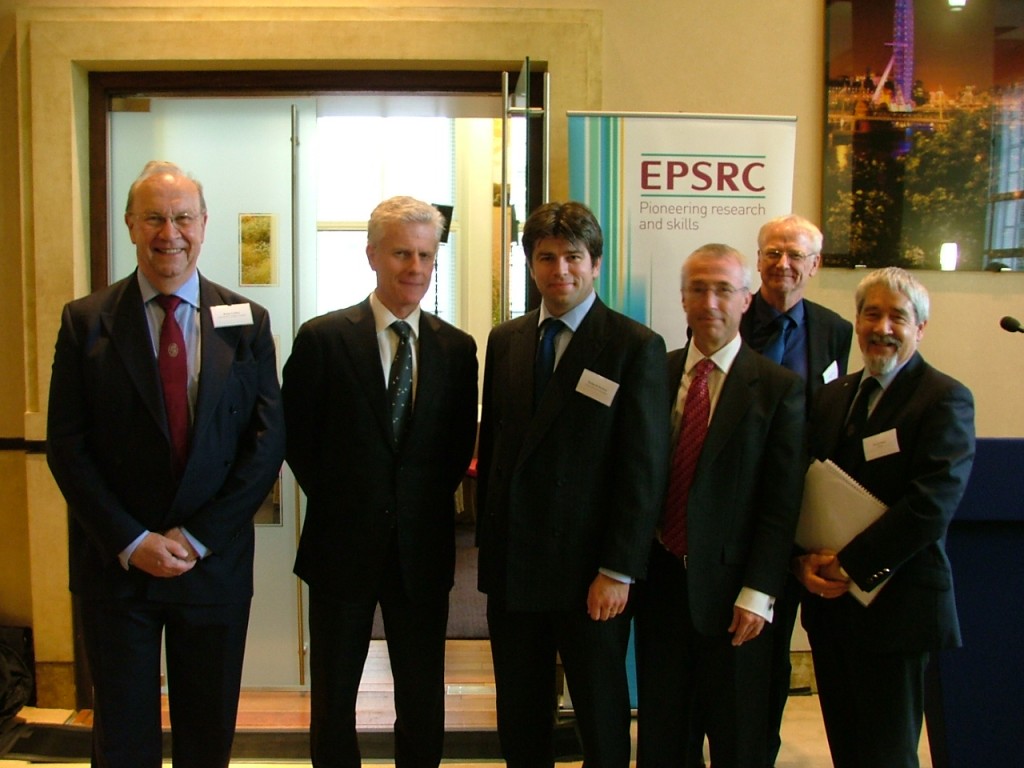 On Monday 3 February 2014, Professor Andy Pike, Director of CURDS, gave oral evidence to the House of Commons Communities and Local Government Select Committee Inquiry into Fiscal Devolution to Cities and City Regions. The second oral evidence session examined the process of devolving powers, governance, business rates and borrowing; equalisation and redistribution; and non property taxes. CURDS submitted written evidence to the Select Committee Inquiry.
On Monday 3 February 2014, Professor Andy Pike, Director of CURDS, gave oral evidence to the House of Commons Communities and Local Government Select Committee Inquiry into Fiscal Devolution to Cities and City Regions. The second oral evidence session examined the process of devolving powers, governance, business rates and borrowing; equalisation and redistribution; and non property taxes. CURDS submitted written evidence to the Select Committee Inquiry.
Category Archives: Research
Funded #ibuild #PhD – Securing Private Sector Investment in Public Infrastructure: An International Comparative Analysis
Reference Code: GPS11
Closing Date: 5th February 2014
Details:
Name of the Supervisors
Professor Andy Pike, Centre for Urban and Regional Development Studies (CURDS)
Dr Oliver Heidrich, School of Civil Engineering and Geosciences (CEGS)
Dr Jane Gibbon, Newcastle University Business School (NUBS)
Sponsor
iBUILD (EPSRC and ESRC)
Duration of the Award
Three years
Project Description
Financing public infrastructure renewal and development presents acute problems for governments internationally in the context of changing demands for infrastructure services, shifting models of valuation, climate change, energy resource shortages, innovative technologies and growing interdependencies between infrastructural systems. Such concerns have been accentuated following the global financial crisis, economic downturn and recession, state austerity and fiscal consolidation and the expected role of infrastructure as a generator of economic recovery as well as financial savings. The research aims to better understand and explain the models, valuation, roles and processes of private sector investment in public infrastructure in an international comparative context.
Value of the Award and Eligibility
A full award covers tuition fees at the UK/EU RCUK rate and an annual stipend of £13,726 for up to three and a half years. Applicants must meet the EPSRC’s eligibility criteria.
Person Specification
To apply you must have:
- achieved or be undertaking an MA/MSc programme in a relevant area
- knowledge and experience of public and private sector finance, investment institutions, economic development and regeneration policy and institutions, and public infrastructure funding
- commitment and knowledge of working on a multi-disciplinary research project and quantitative and qualitative methodologies and analyses
- commitment and willingness to undertake a PhD studentship research project and work collaboratively within the iBUILD research centre.
How to Apply
You must apply through the University’s online postgraduate application form selecting ‘PhD School of Geography, Politics and Sociology – Geography’ as the programme of study. Please insert the code GPS11 in the studentship/partnership reference field. Please also include reference CURDS-iBUILD2014 in the research proposal field.
A CV and cover letter, quoting the studentship code GPS11 and reference number CURDS-iBUILD2014 should also be sent to: Professor Andy Pike, Centre for Urban and Regional Development Studies (CURDS), e-mail: andy.pike@ncl.ac.uk.
Further Information
For further details, please contact:
Professor Andy Pike
Centre for Urban and Regional Development Studies (CURDS)
E-mail: andy.pike@ncl.ac.uk
Outstanding #sustainability #PhD scholarships available
Applications are open for three generous PhD scholarships through the Newcastle Institute for Research on Sustainability. The PhD topic can be anything that fits within the institute’s broad research programme.
Applicant’s should visit here to download the relevant application forms:
http://www.ncl.ac.uk/sustainability/research/studentships.htm
and speak to an appropriate Newcastle University academic to devise a project. A number of indicative PhD topics have been placed on the web by CESER academics.
‘Natural’ engineering offers solution against future #flooding
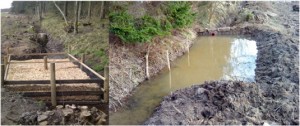 Back-to-nature flood schemes which use the land’s natural defences to slow river flow and reduce flooding could be a cost-effective way of tackling one of the biggest problems facing the UK today.
Back-to-nature flood schemes which use the land’s natural defences to slow river flow and reduce flooding could be a cost-effective way of tackling one of the biggest problems facing the UK today.
The schemes – which include capturing flow upstream to prevent floods downstream where they are likely to have a greater impact on infrastructure and homes – have been trialled as part of a five-year research project by experts from Newcastle University in partnership with the Environment Agency.
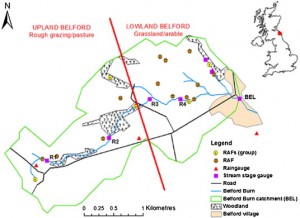 Using Belford Burn in Northumberland as a demonstration, the team have shown that by changing and hindering the natural flow pathways within a small catchment system, it is possible to manage the amount of run-off from the land. This reduces the risk of flooding in low-lying areas and also cuts down on pollution by preventing phosphorous and nitrates from being washed off the land.
Using Belford Burn in Northumberland as a demonstration, the team have shown that by changing and hindering the natural flow pathways within a small catchment system, it is possible to manage the amount of run-off from the land. This reduces the risk of flooding in low-lying areas and also cuts down on pollution by preventing phosphorous and nitrates from being washed off the land.
Published this month in the academic journal Science of the Total Environment, the findings were presented last week at the House of Commons Office of Science and Technology to inform the Government’s Environment White Paper.
Research lead, Dr Mark Wilkinson, who carried out the work while at Newcastle University and is now based at the James Hutton Institute in Aberdeen, said: “Climate projections for the UK suggest that total rainfall during winter months will continue to rise and with it the risk of flooding.
“What we have shown at Belford is that by employing so-called ‘soft engineering solutions’ to restrict the progress of water through a catchment – disconnecting fast-flow pathways and adding storage – we have been able to reduce the risk of flooding in the lower areas and, most importantly, in the town.
“Belford is not unique and there are many other areas around the UK where these solutions could make a significant impact and potentially protect peoples’ homes from some of the more severe flooding we are seeing at the moment.”
Strategies for Natural Flood Management (NFM)
Natural Flood Management aims to reduce the downstream maximum water height of a flood – the peak – or delay the arrival of the flood peak downstream, increasing the time available to prepare.
This is done by restricting the progress of water through a catchment and relies on one, or a combination of four key mechanisms which work with the environment to provide a sustainable solution to the problem:
• Storing water such as ponds, ditches and field attenuation bunds
• Increasing soil infiltration through the creation of ‘infiltration zones’ to help water get into the soil at certain locations, for example tree belts.
• Slowing water by increasing resistance to its flow, for example planting in the floodplain or riverside woodland
• Redirecting the water by channelling it away from the main flow into temporary water storage areas or buffer zones to hold the water back until the flood peak drops or restoring river meanders. This increases the length of the river and decreases its slope, slowing down the flow
Costing around £200,000, the Belford scheme was installed after a study of the area suggested the cost of a full conventional flood defence scheme for the town would cost in the region of £2.5 m.
“The situation in Belford is typical of many rural towns around the UK that are at risk of flooding,” explains Dr Paul Quinn, based in the School of Civil Engineering and Geosciences at Newcastle University.
“It is a town with a long history of flooding but the floods tend to be short-lived – albeit severe – and only tend to affect a small number of properties. A feasibility study concluded that traditional flood defences were not suitable because of the high-cost, lack of space for flood walls and banks and the relatively small number of properties involved.”
Just five months after the feasibility report was published, the July 2007 storm hit the North of England and ten homes and businesses in Belford were flooded. It was after this event the Newcastle University demonstrator project was launched.
“One of the main reasons why the Belford scheme has been such a success is because we’ve had the support of the community and local landowners behind us,” explains Dr Quinn, who has since carried out a second Catchment Management Scheme at Netherton Burn, Northumberland.
“There is no single solution to flooding – no ‘silver bullet’ – but what the Belford scheme has shown us is what can be achieved with local support and a thorough understanding of the land and the local environment.”
Source information:“A framework for managing runoff and pollution in the rural landscape using a catchment systems engineering approach.” M Wilkinson, P Quinn, N Barber, J Jonczyk. Science of the Total Environment January 2014. Volumes 468–469, 15 January 2014, Pages 1245–1254
DOI: 10.1016/j.scitotenv.2013.07.055
http://www.sciencedirect.com/science/article/pii/S0048969713008231
Research job #iBUILD and #CESER #infrastructure #systems modeller
iBUILD (Infrastructure BUsiness models, valuation and Innovation for Local Delivery) is a major EPSRC and ESRC funded research programme to improve the delivery of infrastructure systems and their services they provide. iBUILD focuses on urban infrastructure where interdependencies between infrastructures, economies and society are most profound.
You will join the iBUILD team and develop and demonstrate new approaches to modelling the technical and market risks and opportunities associated with the interdependence of modern infrastructure systems. For more details please visit:
or contact iBUILD Director: Professor Richard Dawson (richard.dawson@newcastle.ac.uk) or iBUILD Centre Manager Dr. Claire Walsh (claire.walsh@newcastle.ac.uk) directly
Symposium on #urban #integration funded by @COSTOffice
 CESER and the members of COST Action TU0902 (Integrated Assessment for Urban Sustainability) are delighted to announce a symposium on Urban Integration 2014, which will take place 6-7th March 2014 in Sheffield, UK.
CESER and the members of COST Action TU0902 (Integrated Assessment for Urban Sustainability) are delighted to announce a symposium on Urban Integration 2014, which will take place 6-7th March 2014 in Sheffield, UK.
https://blogs.shu.ac.uk/urbanintegration/
This two day symposium will explore how state of the art approaches to integrated assessment are helping understand the complexity of urban areas and assist in the implementation of integrated strategies which typically seek to reconcile urban concerns such as energy, transportation demand, land‐use planning, construction of new civil infrastructure and governance.
Professor Richard Dawson (CESER director and COST Action Chair), Professor Annemie Wyckmans (NTNU, Norway) and Dr. Stephen Dobson (Sheffield Hallam University), Dr. Oliver Heidrich (Newcastle University) and Dr. Jonathan Koehler (Fraunhofer Institute) will present key results from the COST Action.
In addition to a number of other invited talks on the theme of urban integration, we are extremely privileged to be joined by three outstanding keynote speakers:
+ Professor Chris Kennedy (University of Toronto) – Sustainable Infrastructure Group and a leading authority on urban metabolism
+ Professor Christoph Reinhart (MIT) – Works in the field of sustainable building design and environmental modeling and leads the MIT Sustainable Design Lab
+ Professor Gerhard Schmitt (ETH Zurich) – Leads the development of the Simulation Platform for the Future Cities Laboratory, and is a Founding Director of the Singapore-ETH Centre
Registration, and more information, on this exciting event is now open. https://blogs.shu.ac.uk/urbanintegration/
This symposium is organised by COST Action TU0902 which is funded via the European Science Foundation. We look forward to seeing you in Sheffield.
#Urban #climate preparedness in the UK
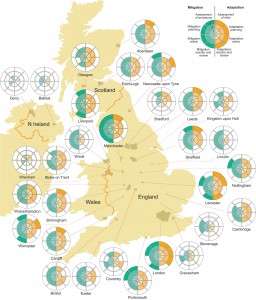 A new map reveals how prepared UK cities are for climate change.
A new map reveals how prepared UK cities are for climate change.
The ability of cities to combat the cause of climate change and to adapt to future weather patterns depends on where we live in the UK, new research suggests.
Scientists at Newcastle University have revealed a “postcode lottery of preparedness” across the country based on what each city is doing to not only reduce greenhouse emissions but also adapt to future climate change and extremes of weather such as flooding and drought.
Devising a new way of ranking cities – the ‘Urban Climate Change Preparedness Scores’ – the team scored 30 cities based on four levels of readiness: Assessment, Planning, Action and Monitoring. Publishing their results today in the academic journal Climatic Change, they reveal huge variation across the UK with London and Leicester gaining the highest scores both for adaptation and mitigation and Wrexham and Derry the lowest.
Newcastle University’s Dr Oliver Heidrich who led the research said it highlighted at a glance the “state of readiness” across the country and how prepared we are for the future. “Of the 30 cities we assessed, all of them acknowledged that climate change was a threat and all except two had a strategy or policy in place to reduce emissions and also adapt to cope better with future weather patterns, in particular flooding,” explains Dr Heidrich, a senior researcher in the Centre for Earth Systems Engineering & Research (CESER).
“But a plan is only any good if you implement it and then assess it to see how effective it has been, this requires a long term investment in the strategies. We found that in many cities this wasn’t happening. In some cases, plans were in place but nothing had been done about them. Many cities published plans and partially implemented associated schemes such as introducing electric vehicles or solar panels as well as making changes to the built environment to reduce the risk of flooding. But very often, no-one was monitoring to see whether it made a difference or had actually made things worse.
“The aim of this research is not to name and shame cities, but if we are to be prepared for the increased occurrences of floods and droughts then we do need to make sure that our climate change policies are in place, that they are working and that the consequences of implementing these strategies are being checked.”
The 30 cities chosen for the study were those selected as part of the European Urban Audit database and are representative of urban areas across the UK.
The Newcastle team then applied the scoring methodology to assess the level of preparedness of each of the cities to climate change, rating from 0-3 against both adaption and mitigation.
London was found to have one of the most advanced strategies in place, mitigating the impact on climate change through, for example, energy efficiency and saving, increasing the use of renewables, waste management and the introduction of greener modes of transport. Leicester also scored highly, carrying out rigorous monitoring and providing regular reports on the city’s carbon footprints.
Other cities, such as Newcastle, had advanced electric vehicle infrastructures in place while Sheffield and Coventry have established programmes to produce more energy from waste and reduce landfill.
Almost all cities had set targets for reducing CO2 emissions although quite a few would not commit to an actual target, figure or timescale, rendering them meaningless; reduction targets varied from just 10% to 80%. Edinburgh was one of those with a deadline, setting a target of reducing carbon emissions by 40% by 2020 and to achieve a zero carbon economy by 2050.
In most cities, adaptation policies lagged behind the mitigation plans. With flooding a key threat in many urban areas – both now and in the future – the team showed that many cities were still unprepared to cope with extremes of weather patterns. Although many had flood protection schemes in place, few had assessed whether they were actually effective.
Dr Heidrich adds: “What this research highlights more than anything is the huge variations in the state of readiness for climate change across the UK, and the method of assessing the preparedness of cities can easily be applied to cities in other countries.
“Although cities of all sizes across the UK acknowledge climate change is a threat, there is considerable spread of measures in place and huge inconsistency in policy between areas and against national and international targets. Local Authorities are pivotal to the implementation of global climate policy so it is essential that we embed adaptation and mitigation strategies within the urban planning framework.”
For more information, to access the outputs and data and to cite the work please refer to: Oliver Heidrich, Richard J Dawson, Diana Reckien and Claire L Walsh “Assessment of the climate preparedness of 30 urban areas in the UK” Climatic Change. DOI: 10.1007/s10584-013-0846-9
Potential profit streams from #water sector #technology innovations – from CESER collaborators Bruce Beck and Rodrigo Villaroel Walker
A few months ago, long time CESER collaborators, Bruce Beck and Rodrigo Villarroel Walker wrote a piece on Growing Blue to Grow Rainbow and posted it at www.growingblue.com (November, 2012). It was prompted by Laurent Auguste’s blog of 5 July, 2012, “Blue Is The
New Green”, in which he argued that green economic growth might now be seen instead as water-sensitive, or blue growth.
Auguste is President and CEO of Veolia Water Americas. Growing Blue to Grow Rainbow asserted that Growing Rainbow — water-nutrient-energy-sensitive growth — might be more appropriate, although indeed Growing Blue might well be the fastest and most effective path toward realizing it.
In their latest post “Growing Profits from Growing Rainbow”, Bruce and Rodrigo attach some hard, monetary estimates to our earlier argument, to convey a rough sense of the cross-sectoral profit-benefit streams to flow from technological innovations in the water sector — Growing Blue, to Grow Rainbow, to Grow Profits, in other words. Their results are based on an analysis for London, UK.
This work forms part of CFGnet’s strategic analyses of innovations for transforming the metabolism of London which are being conducted jointly by Bruce Beck and Rodrigo Villarroel Walker at the University of Georgia, Jim Hall, Director of the Environmental Change Institute, Oxford University, UK, and CESER researchers Richard Dawson and Oliver Heidrich.
Were all four water-sector technologies to be implemented — urine separating toilets; combined treatment of kitchen waste and sewage; pyrolysis of sewage sludge; and producing algae-based biofuels from sewage — in excess of $125M in potential additional annual revenue would accrue, along with nearly $250M in expenditure reductions. This all adds up to a total value of resources recovered or saved each year of roughly $375M.
With thanks to – M. B. Beck and R. Villarroel Walker of the University of Georgia for the contribution!
Download insight ‘Growing Profits, from Growing Blue to Grow Rainbow’ as PDF
CESER academics in @lwec_uk #flooding film
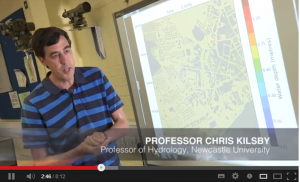 One year after the #ToonMonsoon, the film is released at the Tyneside Cinema. The film is the result of a winning idea submitted to the first LWEC short film competition by Northumbrian Water and Newcastle University.
One year after the #ToonMonsoon, the film is released at the Tyneside Cinema. The film is the result of a winning idea submitted to the first LWEC short film competition by Northumbrian Water and Newcastle University.
‘Flood Force: finding solutions in good company’, features Northumbrian Water staff and CESER academics Professor Chris Kilsby and Professor Hayley Fowler. The film uses the North East’s experience of flooding from extreme rainfall in June 2012 to show how leading UK research can contribute to better decision-making, with a particular emphasis on how business can take action to reduce the risk and therefore the costs of flooding.
The film describes the actions that have been taken by local businesses at large and small scales, whilst calling for more collective action by putting in ponds, green roofs, water butts, permeable paving and other measures which slow down runoff to avoid inundating roads, storm drains, sewers and water courses.
CESER’s experience of crowd-sourcing information on flood risk, city-wide flood modelling and high resolution climate modelling has been central to understanding the convective summer rainfall that inundated Newcastle in 2012.
You can watch the film on youtube.
Lord Deighton launches the new iBUILD #infrastructure research centre
Experts at Newcastle University will lead a £3.5 million Centre set up to investigate how technical and market interactions between our energy, water, transport, waste and digital technology systems can be exploited to get better economic, social and environmental value from our infrastructure.
“These challenges place further pressure on the UK’s existing business models for infrastructure delivery that are in many cases already providing poor value.”
Professor Dawson said the key aim of the new Centre was to develop new business models that are able to reduce costs but also provide better value for people and the environment throughout the design, construction, operation, maintenance, decommissioning or conversion of the infrastructure systems.
“While national scale infrastructure planning remains important, it is at the scale of neighbourhoods, towns and cities – the focus of i-BUILD – that infrastructure is most dense and interactions between infrastructures, economies and society are most profound.
“We aim to harness the power of the Localism Act, City Deals and Local Enterprise Partnerships (LEPs) and the innovation of communities to stimulate local economic growth through infrastructure delivery.
“After all, our national infrastructure and economy are only as good as the sum of their parts and this project offers us a real opportunity to innovate the way we deliver infrastructure and consequently stimulate economic growth.”
In Newcastle, i-BUILD will have a focus around Science Central, the country’s largest inner-city regeneration project that is set to become an exemplar of Sustainability research for the UK. The site will be used as a pilot for the i-BUILD project to demonstrate how infrastructure can be planned and financed in a smarter way to better support local communities and to stimulate growth.
Similar case studies will be developed in Leeds, Birmingham and elsewhere.




